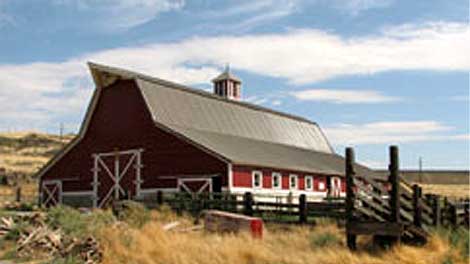KANSAS CITY, Mo. - Thousands of precariously leaning, rotting barns with peeling paint and missing boards dot America's rural landscape.
The aging relics hold a certain romance for many, and interest is growing in numerous states in saving or at least documenting the rickety barns before they become victims of age and urban sprawl, the cost of maintenance too high when they no longer have a practical purpose.
Barn surveys have been started in states including Colorado, Connecticut, Michigan, Missouri, New Hampshire, Ohio, Oklahoma, Vermont and Washington. With photographs and basic information about the architecture, historical character, use and condition of the barns, the surveys will give preservationists a glimpse of rural American and hints about how to save its bucolic landscape.
There is a feeling that losing those kinds of structures means we are losing a connection to a really important part of our country's heritage, said James Lindberg, a field director for the National Trust for Historic Preservation. You would be hard pressed to find a more iconic symbol of rural America.
A 2007 U.S. Department of Agriculture census asked for the first time about barns built before 1960 and found there were more than 664,000 of them. Texas has the most, with more than 51,000, followed by Missouri with about 36,000 and Wisconsin with about 35,000.
In Missouri, awareness of the number spurred the formation last year of the Missouri Barn Alliance and Rural Network, which raises money to survey and find new uses for aging barns. It also created a fund that farmers can borrow from to make repairs and a Facebook page with photographs of old barns grouped by county.
We figured if we've got a lot, we've got a lot to lose, said Bill Hart, the field representative for the Columbia-based Missouri Preservation, a statewide nonprofit that was instrumental in the formation of the barn group. He added that the band of preservationists pushed the panic button.
And maybe for good reason. From the outside, many of the barns make for pretty pictures. On the inside, they're often dilapidated and potentially dangerous messes.
Hart, who has fond childhood memories of catching feral cats in his cousins' barn in Ste. Genevieve County in far eastern Missouri, now spends part of his time photographing old barns. Several of the hundreds he has captured over the past three years have since succumbed to neglect.
It's hard to say how quickly the others are crumbling. But the next agriculture census begins later this year, and the results might give barn advocates some clues.
It will give us a picture of what the change is and the rate of change is, Lindberg said. It may be encouraging, and if it's discouraging, it may cause us to think a little harder about how we can save them.
Only a handful of Missouri farms have been documented thoroughly enough to allow them to be added to the State Historic Preservation Office database of rural farmsteads. Preservationists want to see more farmsteads added to the list and have offered to meet one-on-one with farmers to help them document what remains.
In Connecticut, photos have been taken of 8,200 barns, said Todd Levine, director of Historic Barns of Connecticut. The effort started in 2004, when an architectural historian was hired to document the 100 most visible barns in the state. Levine said the group launched a website in 2007, and the following year a grant program began providing money to assess barns' conditions and look at ways to save and reuse them.
The first step in preservation is documentation, so we need to know what we are losing to know what we need to do to protect them, Levine said.
Back in Missouri, barn enthusiasts are being encouraged to attend an upcoming meeting where the preservation group plans to discuss potential partnerships with other organizations to encourage more people to document their barns and perhaps consider reusing them as homes or businesses.
We are losing them fast, Hart said, so that is one of our first efforts to try to get as many of them documented as possible.
More information


